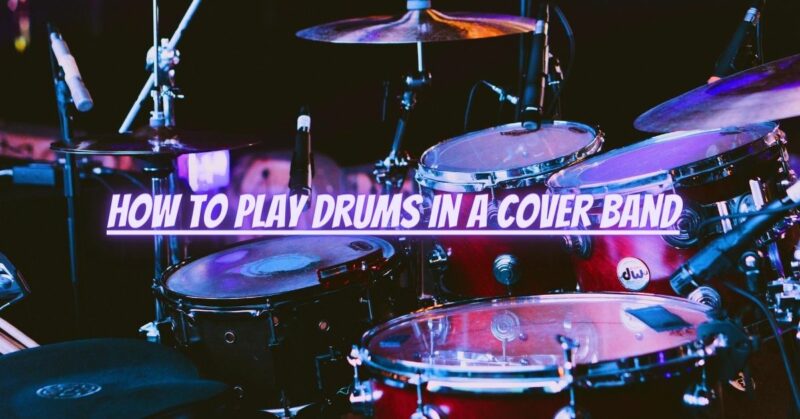Playing drums in a cover band requires versatility, adaptability, and a deep understanding of various musical styles. As a drummer in a cover band, your role is to recreate iconic drum parts, capture the essence of different genres, and deliver dynamic performances that resonate with the audience. In this article, we will explore strategies and techniques to help you excel in playing drums in a cover band, ensuring that you maintain the spirit of the original songs while leaving room for personal interpretation and creativity.
- Study the Original Recordings: Immerse yourself in the original recordings of the songs your cover band performs. Pay close attention to the drum parts, grooves, fills, and overall feel of the music. Study the nuances of the drummer’s playing style, dynamics, and accents. Analyze their techniques, such as ghost notes, ghost strokes, and cymbal patterns. This deep understanding will enable you to recreate the songs faithfully and capture their unique essence.
- Capture the Feel of the Original Drumming: While it’s important to replicate the drum parts accurately, it’s equally vital to capture the feel of the original drumming. Pay attention to the groove, timing, and dynamics of the original performances. Focus on subtle nuances like ghost notes, accents, and the placement of fills. By emulating the feel of the original drumming, you can capture the authentic sound and energy that made the songs popular.
- Adapt to Different Genres and Styles: Cover bands often perform a wide range of musical genres and styles. Familiarize yourself with the characteristic drumming styles of each genre, such as rock, pop, funk, blues, or disco. Study the drumming techniques, patterns, and rhythmic motifs associated with each style. By adapting your playing to suit the specific genre, you can recreate the songs with authenticity and ensure that the band captures the spirit of each genre accurately.
- Add Personal Touches: While it’s essential to faithfully reproduce the drum parts, don’t be afraid to add your personal touch to the performances. Inject your creativity and musicality into the drumming, incorporating tasteful fills, variations, and improvisational moments where appropriate. This allows you to bring your unique style to the songs while respecting the original arrangements.
- Communicate with Bandmates: Effective communication is crucial in a cover band. Discuss the arrangements, transitions, and specific drumming details with your bandmates. Understand their expectations and provide input on how the drum parts can be best represented. Collaborate and listen to each other, ensuring that the entire band is working cohesively to recreate the songs accurately.
- Master Quick Transitions: Cover bands often perform a diverse setlist with rapid transitions between songs. Practice smooth transitions between songs to maintain the energy and flow of the performance. Develop a repertoire of transitional drum fills and patterns that seamlessly connect the songs. Pay attention to the tempos, dynamics, and intros of each song to ensure a seamless flow throughout the set.
- Adapt to Different Drum Kits: As a cover band drummer, you may encounter various drum kits depending on the venue or event. Adapt quickly to different drum kits by adjusting your playing technique and sound settings. Familiarize yourself with the layout and characteristics of each kit, such as different sizes, tunings, or cymbal placements. This adaptability will ensure consistent performances regardless of the drum kit you’re using.
- Engage with the Audience: In a cover band, connecting with the audience is essential. Engage with the crowd through your drumming performance. Maintain high energy, smile, and make eye contact with the audience. Encourage clapping, dancing, and singing along when appropriate. Your enthusiasm will help create an immersive and enjoyable experience for everyone.
- Continuously Expand Your Repertoire: Keep expanding your cover song repertoire to offer a diverse setlist for different audiences. Stay up-to-date with current chart-topping hits and popular songs across various genres. Continually challenge yourself by learning new drumming styles and techniques. The more versatile your repertoire, the better equipped you’ll be to cater to different events and engage a wider audience.
Conclusion: Playing drums in a cover band requires versatility, adaptability, and a deep understanding of various musical styles. By studying the original recordings, capturing the feel of the original drumming, adapting to different genres, adding personal touches, communicating with bandmates, mastering quick transitions, adapting to different drum kits, engaging with the audience, and continuously expanding your repertoire, you can excel in playing drums in a cover band. Remember, while it’s important to honor the original songs, infusing your personal creativity and style will make your performances memorable and enjoyable for both the band and the audience.


